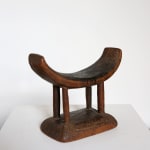Anonymous Ngombe artist
Early 20th century
Wood
height 6 1/4 in
Further images
While non-figurative headrests are common in Eastern and Southern Africa, Congolese examples generally include anthropomorphic or zoomorphic caryatids. In D.R. Congo especially the Kuba and Luba peoples sculpted non-figurative headrests, yet it are the headrests of the Ngombe that can easily compete with the most virtuous examples from elsewhere on the continent. Seen their rarity, a lot of confusion about the origin of this style lingers on in the literature. The Minneapolis Institute of Arts lists their example as ‘Luba’ on their website (97.168.1), while Claude-Henri Pirat in his magnus opus on African headrests attributes the type to the Mongo (“Sur la Piste de l’Eléphant”, 2021, p. 218). Anitra Nettleton in 2007 nonetheless identified the origin of these headrests as Ngombe in her must-read book on the subject ‘African Dream Machines” (p. 176, no. 152), citing an example in the Tervuren museum coming from the Ubangi region (#17200).
With a tradition dating back to Egyptian antiquity, these wooden pillows were meant to elevate their owner’s head from the ground during sleep. Ergonomically, they aligned the spine, yet their main function was to protect intricate hairstyles from dust or being flattened. Elaborate coiffures, which could take hours to create, were more than elements of beautification: they indicated their wearer’s social status and were often important identity markers. Through their use, these headrests related to the world of dreams and were sometimes imbued with benign powers that protected their slumbering owner. Sleepers would usually lie on their side with the neck or the cheek rested on the curved support. Over time, they acquired a lush worn patina due to their intense daily use. As every culture created their own model of headrest, these have been long collected by aficionados for their ingenuous and elegant designs.
Provenance
Colonial collection, Belgium
Emmanuel Ameloot, Ghent, Belgium
Rob Temple, Ghent, Belgium
Pascal Vernimmen, Ghent, Belgium
Duende Art Projects, Antwerp, Belgium, 2023
let's keep in touch
Join our community & never miss out on a DUENDE moment from now on
* denotes required fields
We will process the personal data you have supplied to communicate with you in accordance with our Privacy Policy. You can unsubscribe or change your preferences at any time by clicking the link in our emails.





